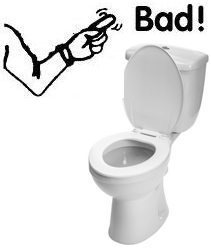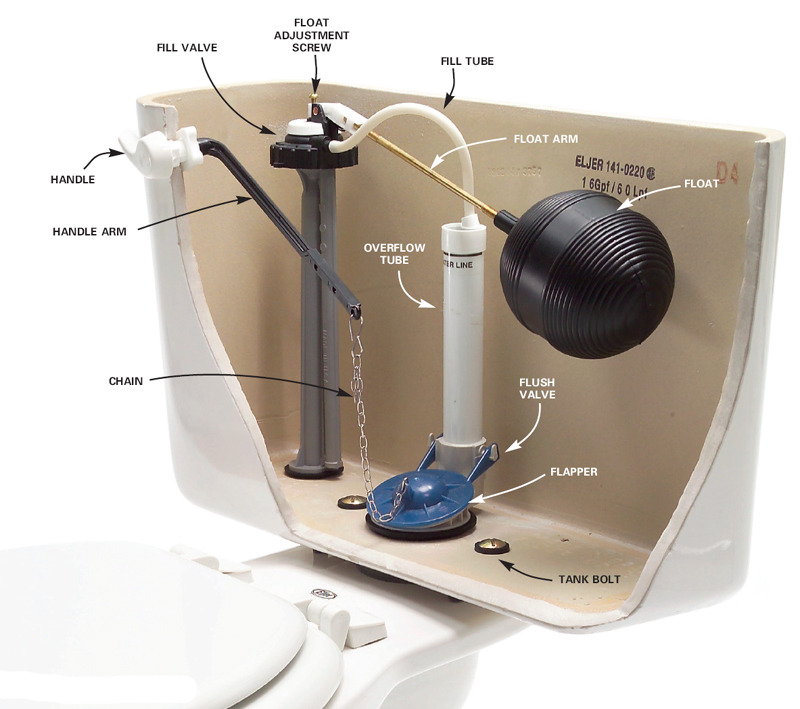 Is your toilet talking to you? Are you losing sleep? Here are a few easy steps on how to get to know your toilet and know what its saying
Is your toilet talking to you? Are you losing sleep? Here are a few easy steps on how to get to know your toilet and know what its saying
 Despite most of the movies we watch today, the hissing going on in your bathroom is not a poltergeist out to get you; however, this does not mean your toilet is not talking to you. The hissing going on in your bathroom may be a leaky toilet that’s simpler to fix than you might think.
Despite most of the movies we watch today, the hissing going on in your bathroom is not a poltergeist out to get you; however, this does not mean your toilet is not talking to you. The hissing going on in your bathroom may be a leaky toilet that’s simpler to fix than you might think.
First you want to understand how a toilet works; simply remove the lid and flush a few times (more than 3 times you’re just playing). You will notice that there are a few basic mechanisms that make your toilet work.
When you push the handle, the chain lifts a flapper, letting a tankful of water fall through the opening in the bottom, into the bowl. As the water level drops, the flapper drops and closes the opening.
A plastic float drops as the water drains. The float is connected to a valve that lets water into the tank when the float is down and stops (or should stop) when the float is up.
In the middle, there’s also an overflow tube that drains water out into the bowl if it gets too high
 At this point you’ve likely caught your toilet doing exactly what it’s not supposed to do; if not here are some likely culprits.
At this point you’ve likely caught your toilet doing exactly what it’s not supposed to do; if not here are some likely culprits.
Chain: Is the chain catching on something? Does it seem to short or too long? If you manually pull the chain up and down does it work ok? You may want to replace the chain with a rubber line to prevent catching. Some people have threaded the chain through a plastic straw to make it smoother. You can also use dental floss for a temporary fix and according to some this works better than the chain
Flapper: The flapper takes the brunt of wear n tear inside your tank, and often needs to be replaced every 5 years to prevent any slow leaks.
When you push down on the flapper with your hand does it stick or stop leaking into the toilet? Is the flapper aligned with the hole? If you have a ball seal instead of a flapper, is the wire that lifts the ball straight and does it move freely?
Sediment and Lime: This can be a horror sight in some states with extremely hard water. An old toothbrush and Lime-A-Way works great on an empty tank. You can also remove the parts to give them a more thorough scrub. Cleaning beneath the flapper, and the hole it goes in can often solve leaking issues.
Sometimes leeks are sneakier and you periodically hear the toilet go on and you know that no one has used it in several hours; you may a have slow leek. This can be checked by putting some food dye or dye tablets in the tank and come back in a few hours and see if there is dye in the bowl.
Valve and float: Take a look at the water line when the tank fills up. You want the water line at the water sweet spot, which is approximately 2.5cm from the top of the tank. Too little water can cause the flapper to not stay secure, and too much can also allow water to seep through given excess pressure.
If the float is around the valve post, pinch the metal clip with a pair of pliers and slide the float down on the wire.
If the float is a ball on an arm, try turning the small screws on top of the valve. Sometimes, you can also bend the arm further down (remember less is more). Be careful to do this when the tank is full so you don’t overdo it and end up with water on the floor.
Make sure the float moves smoothly and nothing is obstructing it. The float can sometimes get water into it. Simply remove it, twisting in counter clockwise and give it a shake; if there is water inside its time to replace it.

When you pull up the float by hand the water should stop filling the tank; if it doesn’t, and you have tried all the above, you might need to replace the refill valve assembly. This is a bit more complicated, so be sure and read all the instructions that come with your replacement valve and if things get too complicated contact us to do it for you.









